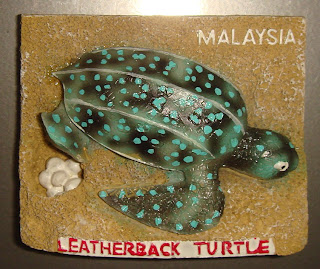Aug 29, 2009
.jpg)
The leatherback turtle (Dermochelys coriacea) is the largest of all living sea turtles and the fourth largest modern reptile behind threecrocodilians. It is the only living species in the genus Dermochelys. It can easily be differentiated from other modern sea turtles by its lack of a bony shell. Instead, its carapace is covered by skin and oily flesh. Dermochelys coriacea is the only extant member of the familyDermochelyidae. Instead of teeth the Leatherback turtle has points on the tomium of its upper lip. It also has backwards spines in its throat to help it swallow food. Leatherback turtles can dive to depths as great as 4,200 feet (1,280 metres).
The leatherback turtle is a species with a cosmopolitan global range. Of all the extant sea turtle species, D. coriacea has the widest distribution, reaching as far north as Alaska and Norway and as far south as the Cape of Good Hope in Africa and the southernmost tip of New Zealand.The leatherback is found in all tropical and subtropical oceans, and its range has been known to extend well into the Arctic Circle.Globally, there are three major, genetically-distinct populations. The Atlantic Dermochelys population is separate from the ones in the Eastern and Western Pacific, which are also distinct from each other.A third possible Pacific subpopulation has been proposed, specifically the leatherback turtles nesting in Malaysia. This subpopulation however, has almost been eradicated. The beach of Rantau Abang in Terengganu, Malaysia, had once had the largest nesting population in the world with 10,000 nests per year. However in 2008 only 2 leatherback turtles nested at Rantau Abang and unfortunately the eggs were infertile. The major cause for the decline in the leatherback turtles is the practice of egg collection in Malaysia. While specific nesting beaches have been identified in the region, leatherback populations in the Indian Ocean remain generally unassessed and unevaluated.
Labels: Malaysia, Malaysia - Terengganu







0 comments:
Post a Comment